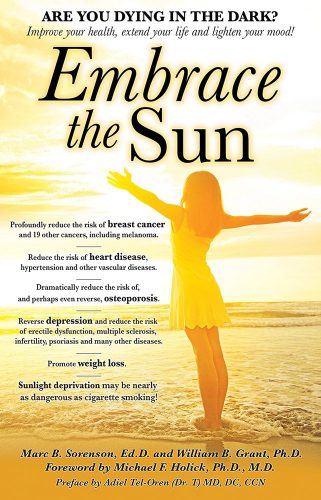Marc Sorenson, EdD, Author of Embrace the Sun
Lymph cancers and sun exposure:

Research published in the journal Blood, demonstrated remarkable risk reduction (due to sun exposure), of cancers known as lymphoid malignancies. These are cancers of the lymph system or lymph cancers. And, they include non-Hodgkin’s Lymphoma, multiple myeloma and classical Hodgkin’s Lymphoma. All of them can be deadly. This is vital information, and I have previously written about the effect of sunlight and its protective effect on children’s’ lymph cancers. http://sunlightinstitute.org/sunlight-helps-children-to-reduce-the-risk-of-non-hodgkin-lymphoma/
First of all, the researchers measured exposure to the sun among residents in different geographic areas. Then they compared the different categories of exposures to the risk of contracting these cancers.
What were the results regarding sun exposure and lymph cancers?
As a result, it was shown that those residents living in the areas with the highest quartile (fourth) of sun exposure were impressively protected against lymph cancers. That is, when compared with those in the lowest quartile. So the overall reduction in risk was 43% reduced risk of Non-Hodgkin’s lymphoma. In addition, they had a 64% decrease in the risk of one of its subcategories, known as diffuse large B-cell lymphoma. Furthermore, the risk of another subcategory of lymph cancers, chronic lymphocytic leukemia, was reduced by 54%. Multiple myeloma was also associated with a reduced risk of 43% among those in the highest quartile of sun exposure.
Especially relevant was the fact that dietary vitamin D was not associated with the risk of lymph cancers.
The researchers stated, “These results support a protective effect of routine residential [sun exposure] against lymphomagenesis [lymph cancer production] through mechanisms possibly independent of vitamin D.”
What is the salient finding of this lymph cancer research and other sunlight/vitamin D/cancer research?
Most noteworthy, in perusing the research of sunlight and disease, I noted that vitamin D was effective for some diseases. Yet, I also noted it was only minimally effective, or ineffective, for others like lymph cancer. Also, it became obvious that exposure to the sun or other sources (sunlamps) was usually profoundly effective.
So should sunlight research on lymph cancer and other cancers focus on vitamin D?
So rather than focus on vitamin D as the only photoproduct of sun exposure, the authors should have examined the big picture. In other words, the holistic sun. Thus, many of these studies should have mentioned the effect of sun exposure on vasodilation, mediated by the skin’s production of nitric oxide. Also, they could have discussed the influence of sun exposure on the production of beneficial serotonin, dopamine, BDNF and endorphin. Vitamin D is an exceptionally important photoproduct of sun exposure, but it is not the only photoproduct. Thus, I predict that a new field of research, regarding other photoproducts of sun exposure, will soon emerge. And, it will provide impressive new knowledge regarding the life-and-health-giving benefits of our most precious friend, the sun.
The takeaway for sunlight and lymph cancer:

In conclusion, these findings are doubly important. They indicate sun exposure has protective effects against lymph cancers independent of vitamin D. This is also true of other cancers we have discussed or will discuss in other blogs. It is probably also true that vitamin D produced through sun exposure is superior to that obtained through food or supplements. Thus, it appears that “Mother Nature knows best.” It seems like the sun’s rays, one of God’s greatest gifts, should not be ignored as powerful therapeutic and preventive therapy.
Read this book:

For more information on the influence of sunlight on lymph cancer, and other destructive diseases, read the book Embrace the Sun, by Sorenson and Grant.
https://www.amazon.com/Embrace-Sun-Marc-B-Sorenson/dp/069207600X
Happy sunning, and do not burn.
Marc Sorenson.
By Marc Sorenson, EdD, for sun exposure and children’s health…
It is well-known that sun exposure is associated with a reduced risk of many major cancers in adults. But what about children? A California study has shown that sun exposure during pregnancies also influences the childhood cancer risk of children who are a result of those pregnancies.[1] In this research, sun exposure, based on the geographical area where the women lived while pregnant, was measured. Then their children were compared in terms of childhood cancer risk, based on high or low sun exposure. Those children whose mothers experienced more sun exposure were less likely to develop acute lymphoblastic leukemia, hepatoblastoma, and non-hodgkin’s lymphoma. The authors of the study make this summary statement: “Our findings suggest that UVR during pregnancy may decrease the odds of some childhood cancers. Future studies should explore additional factors that may be correlated with UVR exposure and possibly include biomarkers of immune function and vitamin D.”
We have discussed in previous blogs the association of sunlight deficiency during women’s pregnancies and the subsequent risk of profoundly increased autism in their children. Therefore, similar results with cancer are not surprising. Safe, non-burning sun exposure has positive effects on at least 100 of the most frightening diseases, many of which will be discussed in my upcoming book that is coauthored by Dr. William B. Grant, and entitled Embrace the Sun. Children, even babies, need at least some sun exposure. And children, if they do not get outdoors in the sun are also subject to a remarkable increase in the risk of myopia.[2]
Take care of your children. Be sure that they play in the sunlight each day, without sunscreen. If any reddening occurs, put them in the shade or cover them up. But don’t deny them their share of sunshine; if you do, their risk of childhood cancers may increase.
[1] Lombardi C, Heck JE, Cockburn M, Ritz B. Solar UV radiation and cancer in young children. Cancer Epidemiol Biomarkers Prev. 2013 Jun;22(6):1118-28.
[2] Rose KA, Morgan IG, J, Kifley A, Huynh S, Smith W, Mitchell P. Outdoor activity reduces the prevalence of myopia in children. Ophthalmology 2008 Aug;115(8):1279-85.
By Marc Sorenson, EdD… Sun exposure benefits…
A very important paper regarding the necessity for sun exposure has recently been published by the journal Medical Hypothesis.[1] It is entitled Regular sun exposure benefits health, and it discusses the pros and cons of sun exposure. One of the salient statements in the paper is that intermittent sun exposure may increase the risk of skin cancer, whereas regular exposure to sunlight might benefit health. For those of us who have for years studied the beneficial effects of sun exposure, the use of the word “might” is the only drawback to the statement. There is no doubt that for the majority of the population, regular sun exposure absolutely protects and enhances health.
Among the diseases mentioned as being reduced or prevented by regular sun exposure are the following:
- Cancers: Colon, breast, prostate and non-Hodgkin lymphoma
- Multiple sclerosis
- Hypertension
- Diabetes
As the authors mention, most of these positive effects of sun exposure were previously ascribed to Vitamin D, but they point out that immune system function is enhanced by sun exposure beyond the effects of vitamin D, and list other non-vitamin D benefits of the sun, including:
- Production of nitric oxide
- Production of melatonin
- Production of serotonin
- Regulation of the circadian clock
I have discussed most of these items on the Sunlight Institute web site, but it was good to see new research that, in particular, separated the health benefits of sun exposure from vitamin D production. The idea that has become popularized during the past decade, that all benefits of sun exposure come from increased vitamin D production, is simply not true and can lead to the supplementation of vitamin D as a “cure” for diseases that may not be influenced by that hormone.
Of course, vitamin D is an exceptionally important photoproduct, and the only natural way to attain it is by exposure to the sun or to other sources of UVB light (such as a sunlamp or a tanning bed). The beauty of using these sources, rather than a vitamin-D capsule, is that all of the benefits of nitric oxide, melatonin, serotonin and circadian entrainment are included in the package.
Safely enjoy the sun, and you then will also safely enjoy better health. Remember not to burn, and to gradually develop a good tan.
[1] van der Rhee H, de Vries, E, Coebergh, J. Regular sun exposure benefits health. Medical Hypotheses 97 (2016) 34–37
By Marc Sorenson, EdD, Sunlight Institute
Often we are told that we are bad parents if we do not protect our children from the sun, and if we follow this heinous advice, we set our children up for a lifetime to compromised physical, mental and emotional health. I recently ran across a paper on sunlight exposure and its influence on children’s risk of non-Hodgkin lymphoma. This research definitely adds another compelling reason to be sure that our children do what is natural for them: play in the sun!
A seven-year investigation in Greece demonstrated that an increment of 15 days of sunbathing at Greek seaside resorts associated to a lower risk of non-Hodgkin lymphoma of 40% but had no affect on Hodgkin lymphoma.[1]
This is important, because extrapolating to 30 days of sunbathing would predict an 80% reduced risk of non-Hodgkin lymphoma in these children.
Our children need to play in the sun and sunbathe optimal health. Good parents will ensure that their children regularly participate safely in those and other sunny activities. And no, they should not use sunscreens. When these children have had enough sun, they should come indoors, seek shade, and cover up with hats and other clothing. They should also develop a good tan as an excellent form of protection against overexposure.
[1] Petridou ET1, Dikalioti SK, Skalkidou A, Andrie E, Dessypris N, Trichopoulos D. Sun exposure, birth weight and childhood lymphomas: a case control study in Greece. Cancer Causes Control. 2007 Nov;18(9):1031-7.


